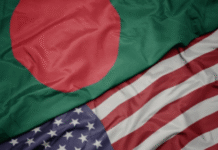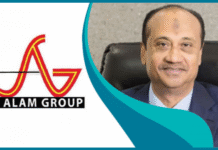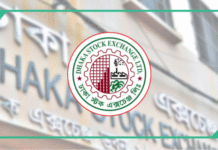BTT Interview
South Korean firm Youngone Corporation owned Korean Export Processing Zone (KEPZ) is a marvel of state-of-the-art factories incorporating natural surroundings in a sustainable manner.
It is a leading global manufacturer of outdoor/athletic clothing, textile, footwear and gear, has business operations and manufacturing units in 14 different countries including Bangladesh, Vietnam, El Salvador and the USA with a workforce of about 90,000. It supplies high-end products to the markets of North America, Europe and Asia.

Kihak Sung, Chairman and Founder of Youngone Corporation (market cap of US$ 1.9 billion), has been here in Bangladesh since 1980 as a foreign investor. When foreign investor did not recognize Bangladesh, Kihak Sung decided to invest to Bangladesh to utilize quota-free status of the country.
He was born to a business family in 1947 in Seoul. Completing his graduation in International Economics from Seoul National University, Sung started business. His three daughters are running some units, especially his middle daughter has been running the company for years already.
The iconic leader is honorary Chairman (immediate past) of Korea Federation of Textile Industries (KOFOTI). It is the national federation of all textile-related industries, with 27 textile industrial associations works to support and promote the development of Korea’s textile industry. Also, he served as the President of the International Textile Manufacturers Federation (ITMF) for the period 2018-2020.
In a recent exclusive interview with Textile Today, Kihak Sung explained his investment journey in Bangladesh, his vision and so many insights on KEPZ. Here is the glimpse of the conversation.
Textile Today: Just after the independence of Bangladesh, Youngone started investment here, what was your inspiration to invest in Bangladesh?
Kihak Sung: Back in 1980, I have started with a small factory with 250 female workers in Agrabad, Chattogram. We were the first foreign investor in the Bangladesh apparel industry. Back then, for sewing, no one hired women, however, we were the first company to do so.
We saw the country’s potential with an abundant workforce. Therefore, we invested heavily after cyclone damage of 1991. Backward linkages followed accordingly.
Textile Today: As a leading foreign investor in Bangladesh, could you share with us what challenges did you face in the beginning and how did you overcome those?
Kihak Sung: At first, it was very difficult for us to set up a sewing factory. There was no infrastructure; Not any supportive facilities. We brought over a hundred technicians and management to Korea for training. Foreign expert-taught Bangladeshi middle management and workers to make top-notch garments.

Then in 1986, we moved to Chattogram Export Processing Zone. When we first invested in Chittagong in the early 1980s, we imported raw fibers such as polyester for carding and processing, then filled them into nylon outerwear for export in volume to the Swedish markets.
In the late ’80s, Youngone manufactured polyester padding for winter garments and supplying it to Youngone and other garment manufacturers in Chattogram.
That was the first manmade fiber (MMF) backward linkage industry in Bangladesh. By the late 1990s, we started supplying raw materials including nylon and polyester fabrics to apparel manufacturers as we had weaving, dyeing, and finishing facilities in Bangladesh.
Textile Today: Kindly share with us the current status of Youngone Group.
Kihak Sung: Currently Youngone Group’s annual turnover is $2.3 billion. We are proud that one-third of the portion comes from Bangladesh. And besides textiles, we have other ventures as well.
Most notably, we have – in KEPZ – 25000 well-trained local employees. Workers are our main driving force. The KEPZ is worker-oriented by providing a modern medical center, fully automated kitchen, canteen, child daycare center, indoor sports facilities, and 9 dormitories are under construction to accommodate 5400 female workers.
Textile Today: Having long experiences in investing in Bangladesh, how do you evaluate the government policy regarding foreign direct investment (FDI)? To attract more FDI, what more can be done?
Kihak Sung: The government’s support is improving in recent years which is great that the govt. realized the sector’s potential. Besides easing policy supports, the govt. must prioritize the long-time foreign investors who have already invested in the country – like Youngone – rather than always looking for FDI’s from new sources.

As new investor needs much longer time to assess and invest in a country. Whereas, old investors always reinvest, which is of course a pivotal plus point for a sustainable FDI in the country.
Textile Today: Kindly share with us about the textile education centers you planned to build.
Kihak Sung: I am building 10 design and development centers (DDC). We have already built 3 and we have plan to build more research centers. In parallel, we have future plan to build a world-class textile university here. So, we can educate and prepare our people as well as young people for the overall industry.
Textile Today: MMF-based apparel trade volume is booming in the global market, however, almost 75 percent of apparel products of Bangladesh are cotton-based. Do you think Bangladesh should come out from the cotton-based apparel production?
Kihak Sung: Bangladesh should never come out of cotton-based garments rather it should go for R&D to improve its strength here as demand for cotton will never run dry. At the same time, the industry should diversify other high-end apparel products intensifying man-made fiber-based apparel which will give it a double edge advantage in the global readymade garment (RMG) market.
RMG entrepreneurs must realize that cotton is not the leading fiber in the market anymore. Rather MMF products like polyester is taking the lead in the global fashion trend and growing faster.
Besides, local manufacturers have been doing polyester and cotton blends for same time they can improve further. Alongside, there are other man-made fibers like nylon, acrylic, natural fibers, viscose, rayons, etc. to blend or innovate to offer to brands in the international market. Most importantly, cotton-made apparel prices going cheaper, whereas MMF garments prices getting higher giving you more profit at times.
Textile Today: Your MMF production project in the KEPZ is an amazing and very significant initiative for the country’s economy. Could you please share with us the overall aspects of the project?
Kihak Sung: Currently, in the KEPZ, we have been establishing three world-class facilities of 120,000 square meters (40000 square meters each), producing MMF with circular knitting, warp knitting, weaving, dyeing, finishing, and lamination work.

Two more will be constructed soon. Altogether, we will have 5 projects in total – of 200,000 square meters – making MMF products and cotton blend which would be crucial for the Bangladesh MMF backward linkage industries.
This is what I envisioned to support the local apparel export industry.
In addition, our future investment project in MMF backward linkage will be ‘recycled’ fiber production in cooperation with other leading global group. This fiber production plant will need a large-scale investment and, most significantly, favorable administrative support, i.e. enabling investment policy and implementation, infrastructure development, improved port facilities. Also we need strong support on FDI.
Textile Today: As you are pioneering in this MMF sector, can you please enlighten other RMG entrepreneurs to share your thought regarding how they can do better in this segment?
Kihak Sung: We are always striving to do better in the MMF segment so that we can provide locally made MMF products to the RMG factories. Again, RMG makers should not abandon cotton, rather they should make higher quality cotton goods to grab increased share in the market.
Youngone has already developed MMF products and would like to contribute further by expanding the facility. Local apparel makers will get MMF products at a competitive price. Instead of importing from abroad, they use Youngone’s locally made MMF products for shorter lead-time benefit.
Youngone more than 20 years of experience in MMF production. We have already established facilities. The govt. and the RMG sector should encourage us more, so that we can enlarge our MMF production capacity, rather than looking for a new source. Otherwise, it will not be profitable enough to invest more here.
We are always supportive of anybody who wants to invest in this segment.
Textile Today: Recently, sustainability is a buzzword in the whole world, but we see, you thought about it so early. What was your motivation to build such an eco-friendly industrial zone in the region?
Kihak Sung: I came from a place where it has gifted land scape. But large-scale industrialization hampers the eco-balance. I wanted to have successful industry alongside the nature’s beauty.
Besides this lesson, in addition, you want to have 3 things together for the community to thrive and people live happily.
- Better job; which industrialization can provide
- Urban life style to live healthy
- Well maintained nature
I wanted to strike a balance with these 3 points here in Bangladesh. I am not interested in making a quick profit. I came here with a long-term vision. Otherwise, I would not have struggled here for over 40 years.
Youngone has set an example in KEPZ – by incorporating all 3 elements. Once the land was as dry as “Texas.” This is my goal here, economically sustainable and environmentally rich. The KEPZ is not just an export processing zone, producing some garments and exporting. We want to make it a model for the world to follow.
Generating 40Mw renewable energy through rooftop solar plants is a significant milestone for KEPZ. The power plant will be linked to the national grid and will be eligible for exporting excess power to the grid under a net metering system. No other industry has such a huge solar power plant with a capacity of established 16MW (out of total 40MW).
Combining blue and green – meaning water and trees – we will plant more valuable trees in the future.
As part of a cultural restoration project, we have fully restored the Sonargaon historical place. (Baro Sardar Bari)
A Youngone team got two standing ovations in one of the factions in the UN for this KEPZ project. The KEPZ is a jewel among Bangladesh’s industries. The govt., people, media have the responsibility to show the world, this eco-friendly project, to successfully invite more significant FDIs.
Textile Today: Kindly share with us the technology aspect in your KEPZ.
Kihak Sung: From high-tech to low-tech, we have installed all kinds of technology to ease workers’ workload here and reduce hard labor. I coach people working here to make hard work an easy one.
Textile Today: Where do you want to see the RMG industry in the future?
Kihak Sung: Our goal is to make ‘Made in Bangladesh’ the number 1 quality product in the world. Yes, it is a tough job, as you need all the support, education system, R&D, know-how, etc. In addition, local factories should design their business in such way that it becomes profitable, and reinvest here for long-term business. We should not be expecting govt. subsidy in the long-run, as it is taxpayers’ money.
Having said that, I will repeat the invaluable role of the GOB to make sure the ease of doing business. With all the elements combined, Bangladesh’s apparel/textile industry will further grow along with reputation of high-quality products.









